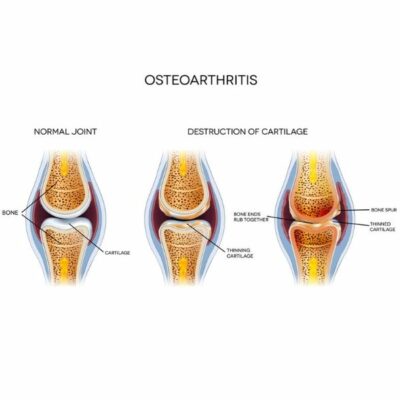Knee Osteoarthritis Specialist

Are you experiencing pain and stiffness in your knee? If so, you may have arthritis in your knee, also known as osteoarthritis. Osteoarthritis is the most common form of arthritis and affects millions of people. Knee osteoarthritis specialist James Mazzara provides diagnosis and both surgical and nonsurgical treatment options for patients in Manchester, South Windsor, Enfield, Glastonbury and surrounding Hartford communities who have developed knee arthritis. Contact Dr. Mazzara’s team today!
What is Knee Osteoarthritis?
Osteoarthritis is the most common form of arthritis. Knee osteoarthritis affects the cartilage on the edge of the bones; it is the slippery tissue connected to the end of the bone that acts as a cushion, providing a smooth sliding surface. In people who have knee osteoarthritis, the cartilage, called articular cartilage, wears away. This causes what is called “wear and tear” arthritis where the bones rub against each other due to the loss of the cartilage cushion. The process of osteoarthritis can begin early in life and may cause pain even before any changes are seen on and x-ray.
In the early phases of osteoarthritis, this is called chondromalacia. Patients with chondromalacia may be very young and it is even seen in teenagers. This is usually treated with therapy although surgery may be an eventual consideration. Dr. James Mazzara, orthopedic knee specialist, treats patients with knee osteoarthritis in Manchester, South Windsor, Enfield, Glastonbury and surrounding Hartford communities.
What Causes Knee Osteoarthritis?
The most common cause of knee osteoarthritis is advanced age. Many of us will develop some form of osteoarthritis in our lifetime. There are a few factors that increase the risk of knee osteoarthritis at an early age including:
- Age – The ability to heal cartilage decreases as a person gets older. Many of the changes in the joint cartilage are built into the aging process. There are changes in the types of collagen, water content, number of cartilage cells that occur as we age.
- Weight – Being overweight increases pressure on the joints, causing more wear and tear on the cartilage, especially the knees. In fact, obesity is a leading risk factor in the development of osteoarthritis.
- Gender – Women are more likely to develop knee osteoarthritis.
- Heredity – Inherited traits may make a person more likely to develop osteoarthritis. Abnormalities inherited in the shape of the bones may also contribute to earlier knee osteoarthritis.
- Athletics – Some types of athletic activities such as long-distance running or soccer can put some people at a higher risk for developing knee osteoarthritis. However, it is important to note that regular exercise will strengthen the joints of the knee and can decrease the risk of knee arthritis.
- Repetitive Stress Injuries – Constant pressure on the knee joint, such as repetitive heavy lifting, kneeling or squatting can stress the joint and cause knee osteoarthritis.
- Previous Joint Injury – Previous joint injuries can stress, tear or wear the cartilage prematurely, causing knee osteoarthritis.
- Other Illness – People with metabolic disorders, such as excessive growth hormone or iron overload are more likely to develop osteoarthritis.
What are the Stages of Knee Osteoarthritis?
Knee osteoarthritis is classified in stages or grades of cartilage damage.
- Grade 0 – Healthy knee, no damage to the articular cartilage
- Grade 1 – Minor damage or softening to the cartilage. Cartilage may be showing pitting or fissures
- Grade 3 – Moderate damage with noticeable signs of wear. Fissures down to the bone.
- Grade 4 – Severe damage with bone-on-bone due to completely worn away articular cartilage.
What are the Symptoms of Osteoarthritis of the Knee?
The usual signs of knee osteoarthritis include pain and swelling with activity. The pain can be a deep aching pain with intermittent sharper pain. Stiffness in the joint, decrease in mobility and creaking or cracking when the joint moves are also indicative of knee osteoarthritis.
How is OA of the Knee Diagnosed?
Diagnosis of knee osteoarthritis is not always simple because an x-ray will not always pick up subtle changes of the knee or articular cartilage. Dr. Mazzara will collect a complete family and medical history as well as perform a physical examination to determine the cause of knee pain. X-rays and an MRI may help Dr. Mazzara diagnose the problem in order to treat the patient. Many patients will come in with x-rays performed in an urgent care center of by their primary care physician. These x-rays often do not include specially positioned weight bearing views which are extremely important in determining the degree and location of the osteoarthritis.
What are the Treatment Options for Knee Osteoarthritis?
The primary goal of treating knee osteoarthritis is to alleviate pain and return patient mobility. Treatment can include the following:
- Non-steroidal anti-inflammatory medication – used to alleviate pain and promote healing. Turmeric or other types of natural anti-inflammatory supplements may also be helpful.
- Exercise – Physical therapy that strengthens the muscles of the knee will make the joint more stable and help decrease pain. Stretching exercises help make the joint more flexible.
- Weight loss – Even a small amount of weight loss can help take pressure off the articular cartilage and decrease knee pain.
- Injections in the knee – Dr. Mazzara may use an injection of corticosteroids or hyaluronic acid into the knee. Steroids are powerful anti-inflammatory drugs. Hyaluronic acid is normally in the knee and helps lubricate the joint for smoother motion.
- Braces – Bracing the knee can often provide a felling of support and stability to the knee while a patient is working on strengthening exercises.
- Lateral heel wedges – for patients with loss of cartilage on the inside (medial) of the knee, or with what is called varus pattern knee arthritis, lateral heel wedges can sometimes help to reduce the stresses applied to the inner knee and decrease pain.
- Platelet Rich Plasma PRP – PRP injections may help relieve the pain from osteoarthritis.
How is Knee OA Treated with Surgery?
For advanced cases of knee osteoarthritis, where traditional non-operative measures have failed to alleviate pain or return range of motion, surgery may be a treatment option. Dr. Mazzara can use a minimally invasive surgery technique called arthroscopic surgery that uses a small camera with small instruments for operating inside the knee. Dr. Mazzara will clean out the irritated joint lining and trim away any area of meniscal tearing to smooth cartilage surfaces. Arthroscopic surgery has limitations in treating arthritis of the knee and is used only in selected cases.
Advanced and severe cases of knee osteoarthritis may require joint replacement surgery. Dr. Mazzara offers computer navigated partial and total knee replacement for patients requiring this procedure. Partial knee replacements may address medial, lateral and patellofemoral arthritis.
If you have questions about knee osteoarthritis and how to treat OA, please contact the orthopedic offices of Dr. James Mazzara, knee specialist in Manchester, South Windsor, Enfield, Glastonbury and surrounding Hartford communities.
